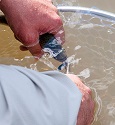 Utah Division of Wildlife Resources: Summer is an important time to catch and release fish properly. Proper catch and release is especially important when temperatures are reaching the hottest they’ll be all year. As the water warms, the amount of oxygen in the water declines.
Utah Division of Wildlife Resources: Summer is an important time to catch and release fish properly. Proper catch and release is especially important when temperatures are reaching the hottest they’ll be all year. As the water warms, the amount of oxygen in the water declines.
Less oxygen makes it harder for fish to recover after fighting with an angler. And in southern Utah, and other spots that have low water levels this summer, fish are more concentrated. Fish that are concentrated into a smaller area are easier to catch, which increases the chance that a fish will be caught and released by anglers multiple times. “Fish survival is all about equipment and technique,” says Ron Stewart, “especially during the hot months of summer.”
Stewart, an avid angler who serves as a regional conservation outreach manager for the Division of Wildlife Resources, says following a few simple rules will greatly increase the chance that fish survive after you release them:
- reel fish in quickly
- unhook fish without bringing their gills out of the water
- if you need to remove a fish from the water, use a landing net. Nets made out of silicon or rubber are the best nets to use.
Stewart, an avid angler who serves as a regional conservation outreach manager for the Division of Wildlife Resources, says following a few simple rules will greatly increase the chance that fish survive after you release them:
- reel fish in quickly
- unhook fish without bringing their gills out of the water
- if you need to remove a fish from the water, use a landing net. Nets made out of silicon or rubber are the best nets to use.
Stewart provides additional details about equipment and techniques to use:
Equipment
- Use strong, heavy tackle — pole, line and leaders — to reduce the time it takes to land fish.
- Use barbless hooks. Barbless hooks are easier to remove from a fish’s mouth.
- Use needle nose pliers or forceps to reduce the amount of time it takes to unhook fish.
- If you need to bring a fish out of the water, use one of the new, specialized nets. In addition to reducing the chance that your hook or line become tangled in the net, these nets — which are often made of rubber or silicon — do less damage to skin, scales and the protective slime layer of fish.
Techniques
- Bring the fish in quickly. Bringing the fish in quickly reduces the buildup of lactic acid and cortisol levels in the fish.
- Leave the fish’s gills in the water as you unhook and release it. Leaving its gills in the water will allow the fish to breathe during the unhooking and release process.
- Fish breathe through their highly sensitive gills. Do not touch the gills while handling the fish.
- If you need to bring the fish out of the water, wet your hands and any surfaces the fish will contact. Doing so will lessen the chance that the fish’s scales and its protective slime layer are damaged. Its scales and slime protect the fish from bacteria, fungus and other disease-causing organisms.
- Avoid hanging a fish from its jaw or mouth. Hanging a fish from its jaw or mouth can break the jaw or backbone of some fish.
